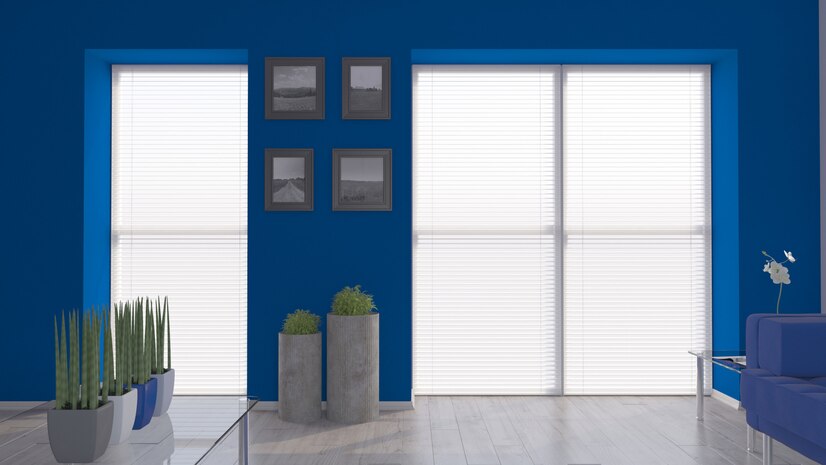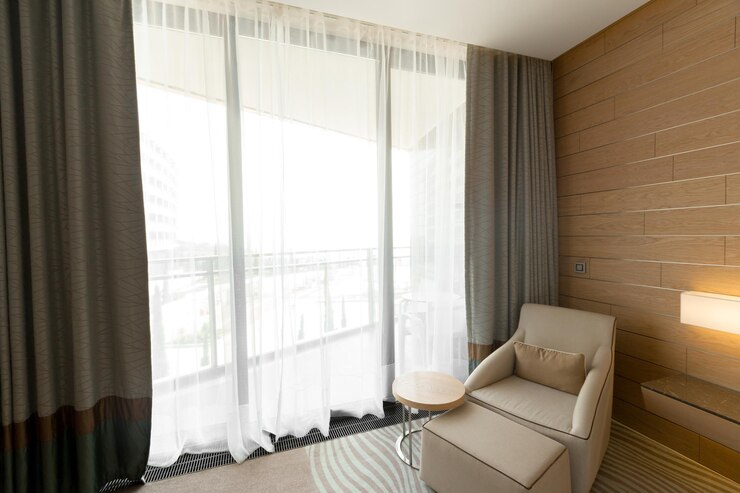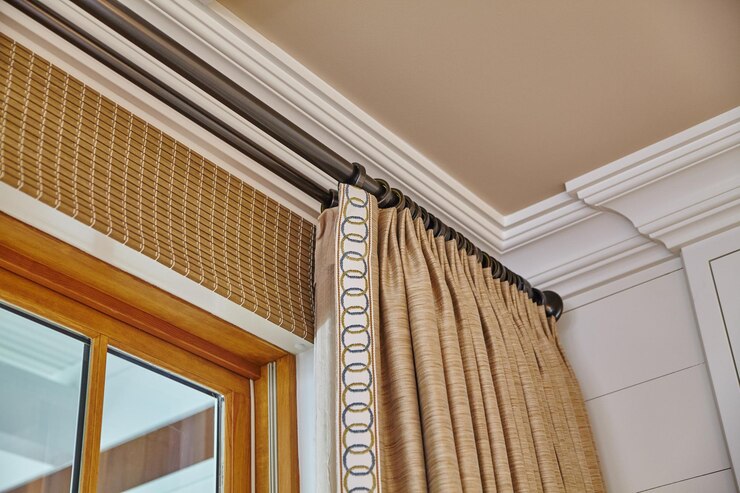
Table of Contents
Key Takeaways |
✔ Achieve depth and versatility by layering curtains and blinds for both style and functionality.
✔ Create harmony by combining bold patterns with solid colors that complement the design.
✔ Add visual interest and richness by mixing different textures like velvet and linen.
✔ Dual curtain rods allow for flexible styling, balancing light control with decorative appeal.
✔ Experiment with curtain lengths to enhance the room’s proportions and add drama.
Home interior projects are a favorite among DIY enthusiasts, with 31% of American homeowners tackling these upgrades themselves. One of the most impactful ways to refresh your space is by mixing and matching window treatments. This approach not only adds a personalized touch to your home but also allows you to get creative with different styles, textures, and patterns.
Ready to elevate your interior design game? Here’s how you can master the art of combining window treatments in Bethpage, NY, for a chic, stylish home.
How to Mix and Match Window Treatments in Your Home
1. Layer Curtains and Blinds
When it comes to window treatments, one of the most versatile and stylish approaches is layering curtains and blinds. This method not only adds visual interest to your windows but also allows for greater control over light and privacy.
Why Layering Works
Layering window treatments is a popular technique because it combines the best of both worlds: the soft, flowing aesthetic of curtains and the functional, structured look of blinds. By layering, you can achieve:
- Enhanced Light Control: Use blinds to block or filter sunlight, while sheer curtains diffuse the light for a softer ambiance.
- Improved Privacy: Blinds provide privacy when needed, and sheer curtains can obscure the view without completely blocking it.
- Added Texture and Depth: The combination of different materials brings richness and dimension to your window treatments.
Choosing the Right Materials

To master the art of layering window treatments, start by selecting the right materials that complement each other:
- Sheer Curtains: Opt for lightweight, translucent fabrics like voile or chiffon. These curtains soften the look of the blinds and create a gentle flow of natural light.
- Wooden or Bamboo Blinds: Choose natural materials like wood or bamboo for your blinds. These add warmth and texture, making the space feel more inviting and organic.
Tip: When choosing colors, focus on neutral or earthy tones that complement your existing decor. A helpful strategy is the 60-30-10 rule: 60% of the room in a primary color, 30% in a secondary color, and 10% as an accent. This ensures that your window treatments integrate smoothly with the overall design of the room.
2. Combine Patterns and Solids
When it comes to dressing up your windows, the combination of patterns and solid colors is a timeless strategy that adds both visual interest and balance to any room. This approach allows you to introduce bold designs without overwhelming your space, creating a harmonious look that’s both stylish and cohesive.
Why Combine Patterns and Solids?
Mixing patterns and solids in your window treatments offers several advantages:
- Balance: Patterns can be visually stimulating, and pairing them with solid colors helps tone down the intensity, creating a balanced aesthetic.
- Versatility: This combination works in any room, from bedrooms to living spaces, providing flexibility in design.
- Focus: Solid colors allow the pattern to be the focal point, drawing attention to your windows without overpowering the room.
How to Mix Bold Patterned Curtains with Solid-Colored Shades
Bold patterns like florals, geometric designs, or abstract prints can instantly add character to your space. The key is to ensure the pattern is in a scale that complements the room’s size; larger rooms can handle bigger, more dramatic patterns, while smaller rooms benefit from more subtle designs. Consider the overall theme of your room when selecting the pattern. For example:
- Modern Spaces: Opt for sleek geometric patterns.
- Traditional Rooms: Choose classic floral or damask designs.
- Eclectic Styles: Don’t be afraid to go for something a bit quirky or unconventional.
Choosing the Right Solid Color
Selecting the right solid color is crucial to achieving harmony in your window treatments. Here’s how you can do it:
- Identify the Dominant Color: Look at your patterned curtains and identify the most prominent color in the design.
- Pick a Complementary Shade: Choose a solid color for your shades that complements or matches the dominant color. For example:
- If your patterned curtains feature a lot of navy blue, consider solid shades in a lighter blue or even a neutral like gray or beige.
- For more vibrant patterns, such as those with reds or yellows, a solid color in a toned-down version of the same color can work beautifully.
- Consider Room Color Palette: Ensure that the solid color you select for the shades also complements the overall color scheme of your room. This will tie the whole look together.

Example Combinations of Solid Colors
- Floral Curtains with Green and Yellow Accents: Pair with solid yellow shades to enhance the warmth of the space.
- Geometric Black and White Curtains: Complement with solid gray or charcoal shades for a sleek, modern look.
- Abstract Multicolor Curtains: Opt for a solid neutral shade, like beige or cream, to let the pattern shine.
3. Mix Textures
When it comes to creating a visually stunning space, mixing textures in your window treatments is a game-changer. This technique adds depth and richness to any room, transforming your windows from functional necessities to design statements.
- Velvet Drapes: Velvet is synonymous with luxury. Its plush, dense texture adds warmth and opulence to a room, making it an excellent choice for creating a cozy, inviting atmosphere. Velvet drapes are ideal for living rooms, bedrooms, or any space where you want to make a bold, elegant statement.
- Linen Shades: On the other end of the texture spectrum, we have linen. Linen shades bring a light, breezy feel to your windows, offering a relaxed, natural look that complements almost any decor style. Linen’s airy quality balances the heaviness of velvet, creating a harmonious blend of textures that is both sophisticated and approachable.
How to Match Texture
To effectively mix velvet drapes with linen shades, it’s essential to strike the right balance between the two contrasting textures. Here’s how to do it:
- Choose Complementary Colors: Opt for linen shades in neutral tones, such as soft beige or light gray, that can seamlessly blend with the rich tones of velvet drapes. If your velvet drapes are in a bold color, select a complementary color for the linen shades to create a cohesive look.
- Balance the Weight: The heaviness of velvet can dominate a room, so balance it out by choosing lightweight linen shades that allow natural light to filter through. This ensures your window treatments don’t overwhelm the space, maintaining a light and airy feel.
- Consider the Room’s Overall Design: Pairing velvet and linen works best in rooms that already have a mix of textures, such as a combination of wood and metal furniture. Use this window treatment mix to enhance the room’s existing decor, rather than clashing with it.
Why Mixing Textures Works
Mixing textures in window treatments adds depth and interest, making your space feel more dynamic and inviting. Here’s why it works and how to use it in your home.
- Adds Visual Interest: By mixing heavy velvet with light linen, you create a layered look that draws the eye. This combination of textures adds visual interest and makes your window treatments a focal point in the room.
- Enhances Functionality: Velvet drapes provide excellent insulation and light-blocking qualities, while linen shades allow for privacy without sacrificing natural light. Together, they enhance the functionality of your window treatments, offering the best of both worlds.
- Creates a Dynamic Atmosphere: The contrast between luxurious velvet and casual linen creates a dynamic atmosphere in any room. This mix of textures can make a space feel both polished and comfortable, striking the perfect balance between formal and informal.
4. Use Dual Curtain Rods

When it comes to enhancing the aesthetics and functionality of your windows, using dual curtain rods is a game-changer. This approach allows you to mix and match window treatments with ease, providing both style and practicality.
Light Sheers with Heavier Blackout Curtains
One of the best combinations you can achieve with dual curtain rods is pairing light, airy sheers with heavier blackout curtains. Sheers add a delicate touch, softening the light that filters through, while blackout curtains offer the perfect solution for blocking out sunlight or street lights at night.
Benefits of Using Dual Curtain Rods
Incorporating dual curtain rods into your window treatments offers several benefits, making it a popular choice for homeowners looking to elevate their interior design.
- Versatility: Easily switch between light and privacy by drawing the sheers or blackout curtains as needed.
- Layered Look: Achieve a rich, layered effect that adds depth and dimension to your windows.
- Enhanced Control: Regulate the amount of natural light and privacy with precision.
How to Install Dual Curtain Rods for Your Window Treatments
Installing dual curtain rods is a straightforward process that requires just a few steps:
- Choose the Right Rods: Select sturdy rods that can support the weight of both your sheers and blackout curtains.
- Measure Your Windows: Ensure you measure the width and height of your windows accurately to determine the correct rod length.
- Install the Brackets: Mount the brackets for the rods, ensuring they are level and secure.
- Hang Your Curtains: Start by hanging the sheers on the inner rod, followed by the blackout curtains on the outer rod.
5. Play with Lengths
When it comes to creating a unique and stylish look in your home, playing with the lengths of your window treatments is a game-changer. By mixing floor-length curtains with cafe-style blinds, you can achieve a perfect balance between functionality and aesthetics.
Floor-Length Curtains
Floor-length curtains are a classic choice for adding elegance and drama to any room. They draw the eye upward, making ceilings appear higher, and they create a sense of luxury. These curtains are perfect for living rooms, dining areas, or bedrooms where you want to add a touch of sophistication.
Cafe-Style Blinds
Cafe-style blinds are a fantastic option for adding a cozy and casual vibe to your space. These blinds typically cover the lower half of the window, offering privacy while still allowing natural light to flood the room. They’re perfect for kitchens, bathrooms, or any space where you want a mix of light and privacy.
Floor-Length Curtains with Cafe-Style Blinds
The key to successfully combining floor-length curtains with cafe-style blinds lies in the balance. Here’s how you can do it:
- Layer for Depth and Drama: Use cafe-style blinds on the lower half of your windows for privacy and light control. Pair them with floor-length curtains that flow from the ceiling to the floor.
- Choose Complementary Colors: Opt for neutral or muted tones for your cafe-style blinds to keep the look subtle and cohesive. For your floor-length curtains, choose colors that either contrast beautifully or match harmoniously with your blinds.
Additional Tips for Mixing and Matching Window Treatments
When it comes to creating a unique and stylish look with your window treatments, there are always extra touches that can make a big difference. Here are some additional tips to help you master the art of mixing and matching:
✔ Add Decorative Trim

Enhance your window treatments by adding decorative trim or edging. This could be a contrast band along the edges of your curtains or a unique tassel trim. Decorative trims can add a touch of elegance and help tie different window treatments together.
Tip: Choose a trim that complements the existing colors and styles in your room for a cohesive finish.
✔ Use Tiebacks for Versatility
Tiebacks can be both functional and decorative. They allow you to pull back heavier curtains to reveal the lighter shades or sheers behind them, giving you the flexibility to change up the look throughout the day. Plus, they add an extra layer of detail to your window treatments.
Tip: Select tiebacks in materials like rope, fabric, or metal to match the style of your room.
✔ Experiment with Valances and Cornices
Valances and cornices can add a structured, polished look to your window treatments. These top treatments can be paired with curtains or shades to give a room a finished appearance, and they can also be a great way to introduce a new texture or pattern without overwhelming the space.
Tip: Opt for a simple, tailored valance or a bold, patterned cornice depending on the overall style of your room.
✔ Play with Symmetry and Asymmetry
Mixing and matching window treatments doesn’t always have to be symmetrical. Playing with asymmetry can create a striking focal point in a room. For example, you could use a single large curtain panel on one side of the window paired with a Roman shade on the other.
Tip: Keep the rest of the room balanced to ensure the asymmetrical design feels intentional and stylish rather than haphazard.
Frequently Asked Questions
How do I choose the right window treatment for my room?
Choosing the right window treatment involves considering factors like the room’s function, the amount of natural light desired, and the overall decor style. For instance, bedrooms may benefit from blackout shades for better sleep, while living rooms might need light-filtering curtains to maintain a bright ambiance. It’s also important to consider the room’s color scheme and whether you want the window treatments to blend in or make a statement. Additionally, the level of maintenance you’re willing to perform can influence your decision, as some treatments require more upkeep than others. Budget is also a critical factor, as prices can vary widely depending on the material and customization.
Can I install window treatments myself, or should I hire a professional?
Many window treatments, such as ready-made blinds and shades, can be installed by a homeowner with basic tools and skills. However, more complex installations, like custom shutters or motorized systems, often require professional installation to ensure they function correctly and look their best. Professionals can also help with precise measurements, which are crucial for a perfect fit. DIY installation can save money, but hiring a professional may be worth it for difficult installations or if you’re unsure about your abilities. Ultimately, the decision depends on your comfort level with DIY projects and the complexity of the window treatment.
How do I maintain and clean my window treatments?
The maintenance and cleaning of window treatments depend on the material. Blinds and shutters can usually be dusted or wiped down with a damp cloth, while fabric curtains and drapes may require regular vacuuming or even professional cleaning to prevent dust buildup. Some treatments, like cellular shades, may need more delicate handling to avoid damaging the structure. It’s important to follow the manufacturer’s cleaning instructions to avoid voiding any warranties.
Find the Perfect Window Treatments in Bethpage, NY!
Discover the ideal window treatments for your home with East End Blinds & Window Treatments in Bethpage, NY. Our expert team is here to help you mix and match styles and textures to create a space that truly reflects your taste. Visit us in Bethpage, NY, to explore our wide selection and get personalized advice on the best options for your home. Don’t wait—enhance your windows with quality treatments from East End Blinds & Window Treatments today!
